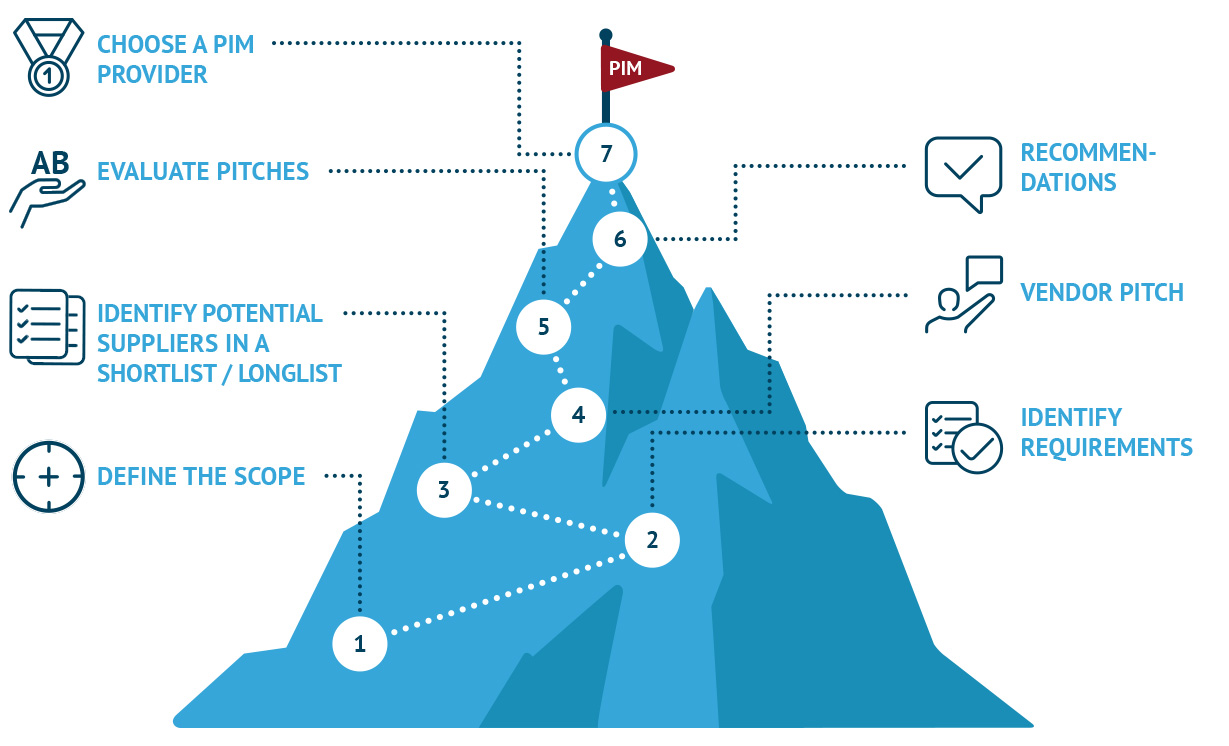Selecting the right PIM
solution for your organisation
How do you find the right system? Seven steps for a successful selection process.
As organisations embrace digital transformation, they often recognise the benefits of a Product Information Management System. Designed to serve as a central and structured repository for all your product information, a PIM system enables you to streamline and simplify data management and enrichment processes. But which PIM system is right for your company? There are a lot of PIM tools to choose from in the market, each with its own strengths and weaknesses.
When selecting a PIM, it’ s not primarily a question of which is the right system per se – but rather which PIM solution will meet your specific needs. After all, the demands placed on a software solution are as diverse as the companies themselves. A PIM system is a critical component among and between your other systems. Thus, the selection process should be carried out with great care and pursue one main objective: to minimise risks. This means, for example, avoiding wrong decisions that were made because specific aspects were simply not taken into account or processes were not thought through. The following seven steps guide you through the selection process to find the PIM system that is best suited for the needs of your company:

1. Define the scope
Before you start, you should always ask yourself the following questions: “What do you want to achieve? Which expectations do stakeholders have of a PIM system?” Before comparing PIM software, you should first define your overall business goals.
You need to know for what purpose(s) you consider implementing this type of data management solution and how you expect it to contribute to the success of your business. Only then will you be able to identify the risks that you may face and find ways of avoiding them.
2. Identify requirements
In order to gain an understanding of a company’s requirements for the PIM system, you must first take a closer look at its business processes. You should involve all departments that will be working with the PIM system or will be affected by its implementation and determine their needs. It is important to understand what motivates these employees and what issues they face.
Suppose you wanted to travel from A to B and had to find the best way to do it. To solve this problem, you would also need a systematic approach. Which car should you choose? Are you travelling on your own or will you need more space? Will a car suffice or would a delivery van be better? You will have to ask the same type of questions when choosing a PIM system.
Another factor to consider is the existing IT landscape as well as the envisioned data model. A list of essential requirements that your PIM system should fulfil will help you keep track of all relevant issues.
Once all essential requirements in the company have been identified, they are set out in a specification.
3. Identify potential candidates
Experienced consultants are familiar with the market and know potential PIM software providers well. They know which solution can fulfil your needs and where the strengths and weaknesses of each software provider lie. In the end, it’s not only a technological issue; a PIM system will only produce satisfactory results if it is in line with your business goals. The consulting firm’s task is to draw up a longlist of about 15 candidates. Qualified business consultants will already take into account your budgetary constraints when negotiating with suppliers. In the first step, all relevant software vendors will be provided with a list of questions based on your main requirements, which must be answered within a specified time. Based on the information supplied by the vendors, a shortlist is compiled with about five top-scoring solutions, which are then further assessed. Subsequently, the consultants will decide with you which two or three suppliers will be invited to present their software.
4. Organise a vendor pitch
The vendors will be given the task of presenting approx. ten use cases. The pitch presentation aims to demonstrate to your key stakeholders how the software works in practice and what are some of its main features. For this purpose, it makes sense, of course, to have them simulate, with some example data, different problems or specific use cases in their presentation. This method is an efficient and relatively objective way to compare the suppliers’ software.
5. Evaluate pitches
Subsequently, the pitch presentations are evaluated and compared. The pros and cons of the respective PIM systems are discussed, and compliance with the requirements are assessed. Of course, costs also play a significant role in the selection process.
6. Recommendations
The results are then summarised for the management. If the parties involved are still in doubt or disagree, the final step can be a “proof of concept” between the last two software finalists. Only when the systems have really proved to be effective in simulations, the costs have been negotiated and an approximate timetable for the implementation has been drawn up, will a recommendation be submitted to the relevant executive body.
7. Choose a PIM provider
If the results of the proposed course of action are convincing, it will be easy to decide which vendor to choose. If, however, several PIM systems are deemed to be suitable for the company, it will be up to the management committee to decide.
Project management beyond the
selection process
In each of the steps of a PIM selection process, it is essential for the consulting partner to work closely with you. Experienced consultants have in-depth market knowledge and the appropriate know-how to understand your needs and guide you through the complexity of a PIM system. This helps to mitigate or avoid risks and reduces implementation costs. Find out more about why professional PIM consulting makes sense for your business.
GET SOCIAL
IN LINE WITH THIS TOPIC
